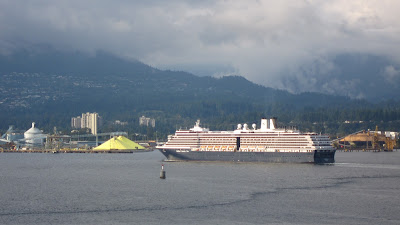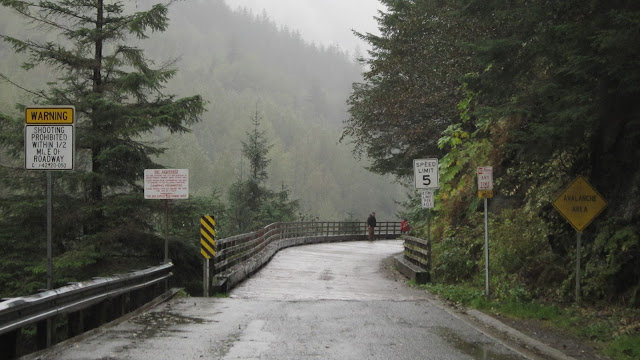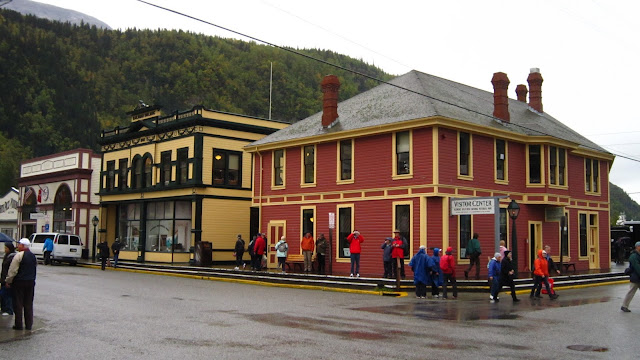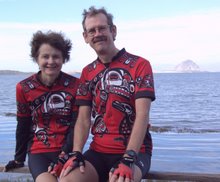And now to China -- but with a week in Alaska for starters. In that week we saw Ketchikan, Juneau and Skagway, spent two days amongst the glaciers, waved "hi" to a wide assortment of wildlife, and finished with an entirely forgettable day in Whittier dropping off some passengers and picking up new ones. We also got 1,869 miles and one time zone closer to China. The big push across the Pacific will come next week.
We pulled out of Vancouver BC past the ever-present pile of sulphur, preceded by a Holland America boat. It turned south to Mexico and we headed north to Ketchikan. We visited here on the Holland America Volendam on our way back from New Zealand, and Ketchikan is still just as much a tourist trap the second time around, except that this time we shared it with only two more cruise ships our size instead of three, meaning 8000 passengers and 1000+ crew members on shore leave were out there, looking for things to do. We did the obligatory walk up Creek Street and Louise modelled her new hat from Vancouver's Hudson Bay Company store. We marveled at the salmon heading upstream to spawn. We admired a totem pole outside the Totem Heritage Center but passed on entering - well, really passed on paying the admission fee as we've seen the better collection in Vancouver. We walked to the edge of town then back to a viewpoint overlooking our ship, the Diamond Princess. OK, that killed an hour . . .
 We returned to the ship for lunch, then headed off to the public library to take advantage of a free hour of wifi, did a little browsing and a little aimless wandering, and by golly it was time to reboard. It was hard, but we did pass on buying the fur bikini set. Wrong shade of red. Later that day a crowd gathered on deck as we passed through an area where hunchback whales tend to hang out. We did indeed see a half-dozen, though none stood still long enough to have his or her photo taken.
We returned to the ship for lunch, then headed off to the public library to take advantage of a free hour of wifi, did a little browsing and a little aimless wandering, and by golly it was time to reboard. It was hard, but we did pass on buying the fur bikini set. Wrong shade of red. Later that day a crowd gathered on deck as we passed through an area where hunchback whales tend to hang out. We did indeed see a half-dozen, though none stood still long enough to have his or her photo taken. Juneau was a far more interesting stop, but the town was not the attraction. Getting off the ship, the town clusters in that valley just ahead. We climbed through town past the ancient Russian Orthodox church and onto Basin Road, past a sign reassuring us that there is a half-mile DMZ around Basin Road protecting us from ex-governors and other Alaskan gun nuts.
Juneau was a far more interesting stop, but the town was not the attraction. Getting off the ship, the town clusters in that valley just ahead. We climbed through town past the ancient Russian Orthodox church and onto Basin Road, past a sign reassuring us that there is a half-mile DMZ around Basin Road protecting us from ex-governors and other Alaskan gun nuts.And what a road it was! A little over two miles from the heart of downtown it turned into a hiking path that climbed into the sky past glorious waterfalls and an ingloriously decaying gold mine that was once the largest in the U.S. Oh, it was good to get out in the woods like that, even though we had to yell out "Hey Bear!" every minute or two to let them know we were in the vicinity. Rangers at Glacier National Park taught us to do this years ago, since bears just hate surprise visits from humans. Let 'em know you're coming and they'll leave is the theory.
Part way up the trail we found a sign telling us that our narrow shelf of dirt and rock was Alaska's first road, servicing gold mines up this valley. That must have been an exhilarating drive! Well, we were thoroughly soaked on our return to the ship, but with dry clothes on him and a hot lunch in him, Jeff managed a second trip out into the steady hard rain to do an hour of Internet at a cafe, mostly catching up on checking the bank and credit card accounts.
Skagway was our third stop. Captain William Moore was a prescient fellow. He had done some prospecting himself and knew that other gold hunters were wandering all over Canada's Northwest Territory. In 1887 he staked a homestead claim in what is today Skagway on 160 acres at the base of White Pass, the lowest pass over the mountains from Alaska to the NWT. He farmed enough to "prove up" his homestead claim, and he waited. And waited. Nine years after he arrived and built the cabin you see here, a few fellows 300 miles to the north were stuffing every sack they owned with shiny rocks that were turning them into millionaires, and Captain Moore's ship came in the next year as the Klondike Gold Rush began and the population went on from 7 Moores in 3 generations to 10,000 mostly single fortune-seekers. Except it was more complicated than that. Those thousands descended onto his property with little regard for fine points like legal title to land, and it took several years of litigation before he, too, joined those first miners in the millionaires club.
The National Park Service today owns a lot of historic downtown Skagway and leases much of it out to stores that agree to properly conserve the buildings and spirit of Gold Rush Skagway. The 1899 Arctic Brotherhood building, a fraternal organization that fizzled out 20 years later, is now the tourist bureau and reportedly the most-photographed building in Alaska thanks to the 8,800 pieces of driftwood adorning it.
The Park Service runs a small but excellent museum that brought the Klondike Gold Rush to life, such as this model of just how many provisions a miner had to bring before the Canadian Mounties would let him cross the border in search of gold. It was supposed to be enough clothing, equipment and food to last him a year, and it weighed approximately a ton - 2,000 pounds!
The vast majority of miners actually hiked from nearby Dyea up the Chilkoot Pass, a taller crossing but several miles shorter. Since it took many trips up and down the trail to bring your ton of goods to the top, short was important. Just as the gold rush was almost over, however, a railroad made it over White Pass and on to Whitehorse, and Dyea became a ghost town. Skagway survived, and the White Pass and Yukon Railroad today is mining tourists better than any of those early settlers mined gold. $117 gets you a 2 1/2 hour round trip to the summit, $129 if you buy it as an excursion from the boat (you get a 4 minute bus trip to the train station for the extra $12), and we saw four pairs of locomotives each pulling about 15 fairly full passenger cars, and that was mid-day on the second of three runs! There were 4 cruise ships in port and we estimate their passengers left close to a quarter of a million in the railroad's coffers that day, plus who knows how much more in the shops in town. OK, we admit it, a few of those dollars were ours as we picked up a stuffed toy for grandson Tyler, whom we see in two weeks.
 But other than bemusement as we captured the illusion of a "stretch" cruise ship from two Norwegian Cruise Line boats docked on a neighboring pier, and astonishment at the number of jewelry stores on the main street (we've never heard of a diamond mine in Alaska, though there's an average of two diamond stores per block in one part of town), we pretty much limited ourselves to the National Park sites and to another hike into the wilderness. Two blocks from the train station you enter the woods and start climbing over a wooden bridge and past a spot overlooking the other 2 of Skagway's 4 cruise ship berths, the last signs of civilization for a while.
But other than bemusement as we captured the illusion of a "stretch" cruise ship from two Norwegian Cruise Line boats docked on a neighboring pier, and astonishment at the number of jewelry stores on the main street (we've never heard of a diamond mine in Alaska, though there's an average of two diamond stores per block in one part of town), we pretty much limited ourselves to the National Park sites and to another hike into the wilderness. Two blocks from the train station you enter the woods and start climbing over a wooden bridge and past a spot overlooking the other 2 of Skagway's 4 cruise ship berths, the last signs of civilization for a while. A 45-minute steep climb on a somewhat rough trail brought us to Lower Dewey Lake. We alternated between views across the lake and up into the towering mountains, then down at our feet at the rocky trail and an amazing variety of mushrooms. Half-way around the lake the off-and-on light mist of the morning became another hard steady rain, and then the trail changed for a quarter hour from a path to a rock scramble on all fours, but once again the chance to get into such stunning nature made the day a big success.
A 45-minute steep climb on a somewhat rough trail brought us to Lower Dewey Lake. We alternated between views across the lake and up into the towering mountains, then down at our feet at the rocky trail and an amazing variety of mushrooms. Half-way around the lake the off-and-on light mist of the morning became another hard steady rain, and then the trail changed for a quarter hour from a path to a rock scramble on all fours, but once again the chance to get into such stunning nature made the day a big success. The next two days involved sightseeing from the decks of our ship, and we lucked out with dry days in the 50s. Jeff visited Glacier Bay on a cruise ship in May 1987, and saw a lot of wildlife and several excitingly large splashes as ice "calved" off the glaciers. On these two days we saw a few whales, a small pod of porpoises and a few dozen sea otters, one of them floating on an iceberg, plus acrobatics from hundreds of starkly colored kittiwakes, but sadly much less than on the earlier trip. The glaciers were also having off days.
That said, the scenery was still awe-inspiring. We'll turn off the audio commentary for a while and let a batch of our favorite shots speak for themselves. To get a sense of the scale, keep in mind that all but the last 3 shots were taken from a deck 75' above the water, and the last three from the top deck at twice that height.
Welcome back. The first shots were in Glacier Bay, the last ones on College Fjord the next day. This second waterway is where a bunch of university science professors sailed into an area previously blocked by ice and named the newly-discovered glaciers after various East Coast schools. We parked for an hour in front of Harvard Glacier, down the street from Vassar and around the corner from Yale, among others.
 Sixty of our fellow passengers missed Glacier Bay. They took an excursion the day before while we were in Skagway, jet-boating 25 miles to Haines for some bald eagle watching. As that heavier rain moved in mid-day, so did an intense wind storm. It was too dangerous for their boat to return to Skagway! Luckily an Alaska state ferry was also stuck in Haines, with 40 - 50 empty staterooms. The eagle-watchers spent the night on that ferry, albeit toothbrush-and-pj-less, and rode it the next morning to Juneau, where Princess chartered a jet boat which brought them to the mouth of Glacier Bay. The rendezvous worked smoothly, and we heard later that some whale and porpoise sightings plus perhaps a free beer or two on the Princess tab left them feeling OK about the incident. In any event, College Fjord was every bit as stunning as Glacier Bay, so they made out just fine. They probably also appreciated that the Diamond Princess came to a dead stop for their reboarding. A half hour earlier our National Park Service guides for Glacier Bay disembarked while we did 16 knots on a southerly course.
Sixty of our fellow passengers missed Glacier Bay. They took an excursion the day before while we were in Skagway, jet-boating 25 miles to Haines for some bald eagle watching. As that heavier rain moved in mid-day, so did an intense wind storm. It was too dangerous for their boat to return to Skagway! Luckily an Alaska state ferry was also stuck in Haines, with 40 - 50 empty staterooms. The eagle-watchers spent the night on that ferry, albeit toothbrush-and-pj-less, and rode it the next morning to Juneau, where Princess chartered a jet boat which brought them to the mouth of Glacier Bay. The rendezvous worked smoothly, and we heard later that some whale and porpoise sightings plus perhaps a free beer or two on the Princess tab left them feeling OK about the incident. In any event, College Fjord was every bit as stunning as Glacier Bay, so they made out just fine. They probably also appreciated that the Diamond Princess came to a dead stop for their reboarding. A half hour earlier our National Park Service guides for Glacier Bay disembarked while we did 16 knots on a southerly course.With pretty much every "sightseeing" spot covered in 15 minutes, and with a steady rain and a temperature of 50, the highlights of our port call were a slow inspection of the lone grocery store, the last chance to buy American products for the next 2 months - and we did come up with $10 of odds and ends to purchase - and a long visit to the cafe to use wifi in one last orgy of connectedness before our week-long crossing of the Pacific. Back on the boat we still had a good cell phone signal so called up family and friends for one last chat before we suspend service 'til our return in late November.
OK, time to let go of North America. For the next 6 days and 7 nights our ship's engines will be pounding as we cover over 3,000 miles to Japan. With lots of time to explore the boat, we'll tell you about our floating palace in our next blog from the other side of the Pacific.





















































No comments:
Post a Comment